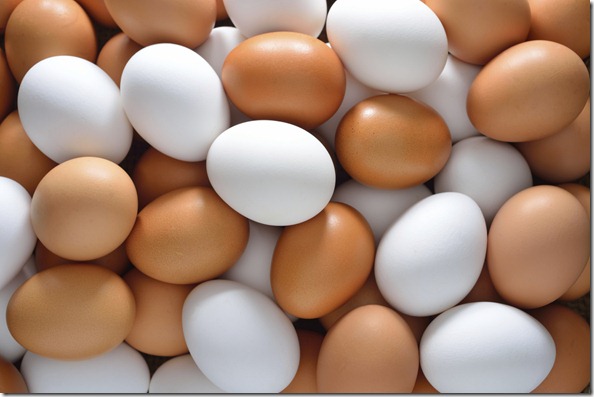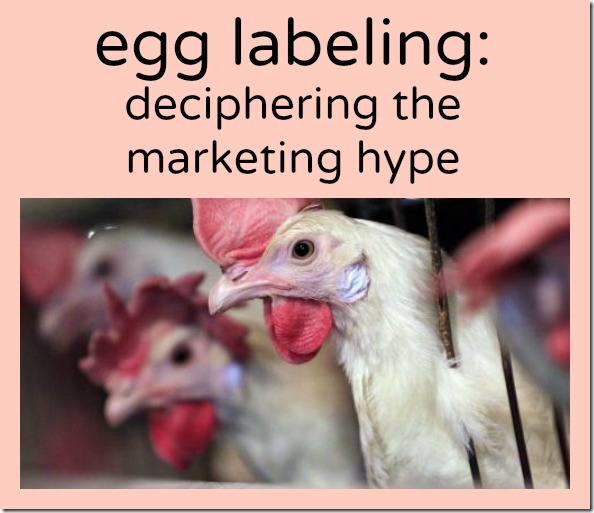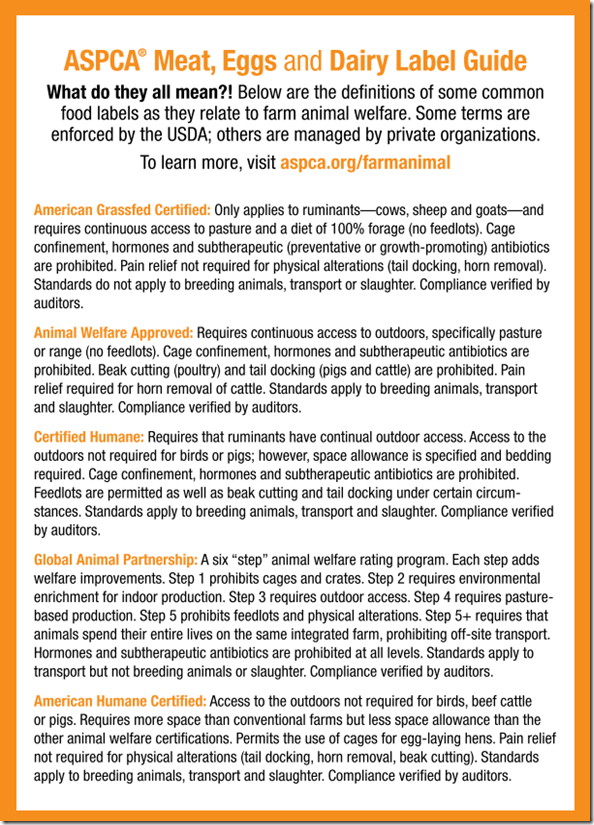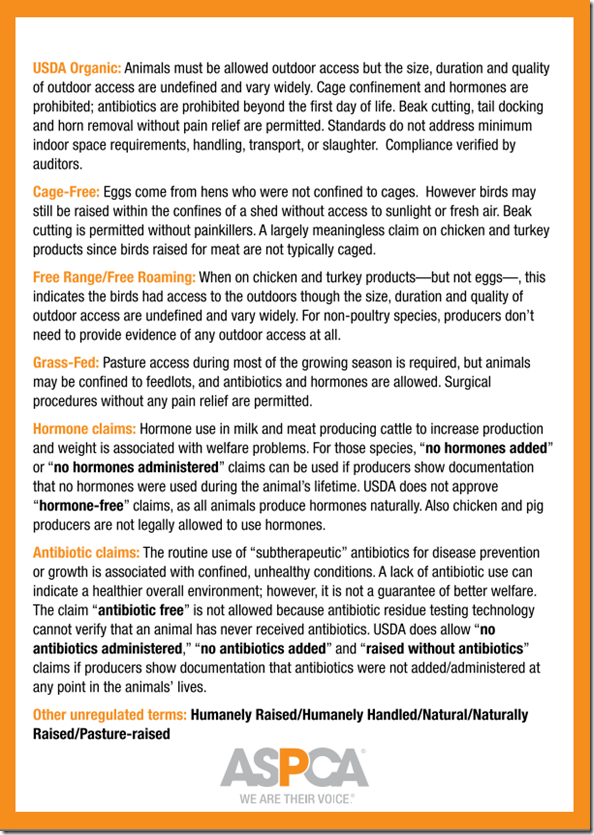… So I asked Daisy the Decoder to help us understand what the heck is going on!
I met Daisy at BlogHer Food. How did she earn her “The Decoder†nickname? Well, she works for the ASPCA and is an expert on what those egg labels actually mean – I’m talking about “organic,†“free range,†“cage free,†etc. I’ve written about this topic before, but when I go to the store, I’m STILL confused by all the flashy terminology. Below, Daisy breaks down what marketing hype and what’s real – and what to look for if you want to buy eggs that come from humanely treated chickens.
Note: all of this refers to eggs bought at grocery stores. Daisy says if you can’t find the certified brands at your grocery store, your safest bet is to buy local eggs at the farmer’s market. You still need to talk to the farmers directly to understand what is going on with their chickens. Plus, then you’re directly supporting a local farmer, which is a win-win!
CAITLIN: Can you talk a little bit about how egg labeling relates to marketing? You told me a bit about how manufacturers are always trying to one-up and catch-up with each other. What problems does this cause for consumers?
DAISY: Labels are understandably a big source of confusion for consumers! It can make you want to throw your hands up in the air. But with a little knowledge, it’s possible to avoid buying products from animals raised in some of the most inhumane conditions. Unfortunately, some of what gets put on meat, egg, and dairy packaging is essentially empty marketing because the terms have no legal definition or no audits to enforce the claims. For example, “natural,†“naturally raised,†“humane,†and “humanely raised,†are all terms with no government agency regulating their definition or verifying that companies are doing anything better than conventional factory farming. Yet companies use them to make their products stand out on the shelves. And then when studies show that consumers see the word “natural†and think more highly of it than organic, companies will rush to stamp that meaningless term on every package and it becomes an arms race.
The best example of that on chicken and egg products is “hormone free.†Chicken and pig producers are not currently legally allowed to administer any hormones to those animals, so if a consumer sees “hormone free†claims on eggs, chicken meat, or pork products they’re not adding any value.
“Cage-free,†the term that many consumers are now looking for to assure that egg-laying chickens did not live their entire lives in tiny, inhumane battery cages, is a good start, but use of the term does not require outdoor access, pasture, or even a minimum amount of space per bird. As a result, birds could be and often are still crammed into indoor, artificially lit sheds with less than a square foot of space per bird.
And as a note, chickens raised for meat are almost never raised in cages in this country, so the term “cage free†on chicken meat is stating the obvious. As a result of these subtle but important differences, consumers can end up inadvertently paying for something they don’t want. To have more certainty of the practices used on the farm, consumers can look for some of the farm animal welfare certifications that require 3rdparty audits, like “Certified Humaneâ€, “Animal Welfare Approvedâ€, or the Global Animal Partnership’s 5-step program. These labels involve on-farm audits and are backed by publicly available standards that prohibit the use of cages and define minimum space, among many other requirements. I recommend people search their websites to find out where the certified products are sold, and what the standards are exactly.
CAITLIN: What, in your opinion, are some labels that manufacturers put on eggs simply to jack up the prices but don’t mean much in terms of animal welfare?
DAISY: Hormone free, as I said before, is an absolutely empty term given that chickens are prohibited from receiving hormones by the FDA. I would also be wary of “free-range†or “free-roaming,†which has no legal definition when it comes to egg production. It typically means that the birds are un-caged, but may be in a barn and if they have outdoor access, the type and length of time they’re allowed outside is not defined. Often I’ll see “pasteurized†on eggs and I can imagine consumers confusing that with “pastured†eggs. Pasteurization is a process of heating a product for food safety concerns. “Pastured†should mean that the birds had access to pasture. Unfortunately, that term is not legally defined by USDA, so consumers who see it on packages should speak to the company or farmer directly if possible to verify that the birds did indeed have access to grass.
“Vegetarian-fed†means that birds are not eating feed with animal by-products, but has no implications on the living conditions of the birds. “Omega-3 enriched†similarly does not mean anything for the birds’ conditions. Animals living and feeding on grass will produce eggs and meat that naturally has higher levels of omega 3 without dietary additions.
CAITLIN: What does "organic" mean for animal welfare?
DAISY: Organic production generally limits the use of hormones, antibiotics and other inputs, and requires that animals’ feed be organically grown. However, the animal welfare standards for the USDA organic label are not currently strong and we have been petitioning the USDA’s National Organic Program to improve them for years. While animals on organic farms are required to have some access to the outdoors, that access is not strictly defined in terms of size, quality, or duration of time. Space per animal is also not defined clearly. These loopholes are allowing large companies to gain organic certification, raising animals in conditions that are barely better than factory farms.
An ASPCA survey recently showed that consumers believe they’re paying for better animal welfare than this when they buy organic. Not only are these standards inadequate for animals’ welfare and below consumer expectations, they’re also undercutting the smaller farmers who are certified organic but raising animals to much higher standards, including true outdoor access or pasture-based farming. Again, the third-party verified animal welfare labels are the best way to go if an assurance of farm animals’ welfare is the consumers’ priority. Alternatively, if shopping at a farmers market, it’s important to ask how their animals are raised: cages, outdoor access, antibiotic use, breed?
The ASPCA has some great pages on factory farming that discuss the basic welfare issues related to each species that can help consumers who chose to eat meat, eggs and dairy avoid factory farmed products. http://www.aspca.org/farmanimal
CAITLIN: I went to Trader Joe’s on Sunday and saw a bunch of different labels, some of which you already addressed. But I also saw “additive free†and more claims about antibiotics and hormones. Can you talk about that?
DAISY: I’ve addressed some of these above, but not additives, and I can say a bit more about the hormone/antibiotics issue. “No additives†is a general claim that a product has not been enhanced with the addition of natural or artificial additives. There is no USDA definition of the term “no additives,†so anyone using the term may or may not be referring to this legal regulation. Even some terms that seem straight forward, like “hormone free†or “antibiotic-free†are not simple to decipher.
As I said, hormones are not used on chickens or pigs but they are approved for use on cows raised for meat or milk, and in those cases consumers avoiding products from animals treated with hormones should look for the USDA regulated terms: “no hormones addedâ€, or “no hormones administered.†The term, “hormone-free†is not approved for use on dairy or beef because all animals produce hormones, so it would be impossible to call a product truly “hormone-free.â€
Many consumers are also looking for assurances that antibiotics have not been given to farm animals on a daily basis to compensate for unhealthy living conditions, thereby creating antibiotic-resistant bacteria on the farm that can travel to consumers. The claim “antibiotic-free†is not allowed because antibiotic residue testing technology is not strong enough to verify that an animal has never received antibiotics. Instead USDA allows “no antibiotics administered,†“no antibiotics added,†and “raised without antibiotics†if producers show documentation that an animal has never received the drugs during their lifetime.
In theory, “pasture-raised†is a good term. Animals should be able to roam freely and have access to pasture, with sun on their backs and dirt to root in. Ruminants like cattle and goats should be able to eat grass for their entire lives, instead of spending their last months on cramped, barren feed lots eating grain. In reality, “pasture-raised†is not a regulated term, so it’s meaning can vary, and the USDA’s definition of “grass-fed†allows for feedlots, antibiotics and hormones. Until the terms are better defined by the USDA, consumers seeking products from animals truly raised on pasture should seek out the three certification programs I mentioned above and American Grassfed Association, (AGA).
For more information, check out the ASCPA’s section on farm animals. You can also check out the “What the Cluck†page. I always thought of the ASCPA as a dog and cat group, but they do a ton of work behind-the-scenes for farm animals and offer many great resources.





I like using the cornucopia institute’s website. I look at their egg, dairy, cereal, protein bar scorecards. It makes life easier for me. I used to spend a lot of time trying to research and make decisions, but I just don’t have that time anymore and they do a lot of the work for me. Thanks for this post! Food labels have gotten quite deluded these days.